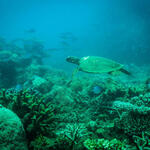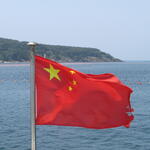- Date: 18 June 2020
- Author: Stephanie Bradley, director of fisheries in transition
One of the biggest threats to the ocean is unsustainable fishing. When done right fishing can benefit people while maintaining balance in nature. But when fishing practices take too heavy a toll on the marine environment, wildlife populations and critical habitats decline, which jeopardizes jobs and a critical food supply.
Fishery improvement projects—called FIPs—are the most widely-used approach for raising standards in fisheries around the world so that species, habitats, and people can all thrive. WWF helped pioneer the approach more than a decade ago and today FIPs account for nearly one in every ten pounds of fish caught worldwide.
After more than a decade of leveraging seafood buying power to catalyze these improvements in fisheries, we now have a good idea of what is working and what parts of the approach need to be improved. There’s never been more incentive to get it right—and fast.
- Date: 24 October 2019
- Author: David Schorr, Senior Manager, Transparent Seas, WWF
The ocean is experiencing stress like never before, and that raises the stakes for sustainable fishing.
In a new report, the Intergovernmental Panel on Climate Change (IPCC) warns that climate change is altering ocean ecosystems, affecting fish populations and the people who depend on them. The report calls for leadership on building better policy for managing and protecting seascapes to improve ocean resilience.
- Date: 31 July 2019
- Author: Michele Kuruc, Vice President, Ocean Policy
Turtles entangled in plastic bags; whales dead and filled with plastic; sea lions trapped in six-pack rings: when images like these go viral, we’re motivated to do whatever we can to help ocean wildlife. Companies that produce and use plastic have opportunities to make and keep commitments to eliminate plastics in nature, but what if you’re not in the plastics business?
Plastics makers and commercial plastics buyers aren’t the only businesses that can save marine life. In fact, there is one sector that can have an even larger impact—seafood.
Plastics aren’t killing as much wildlife as unsustainable fishing
What we eat from the ocean impacts the marine world more than the single-use plastics that accompany our food.
Unsustainable fishing remains the single largest driver of declines in ocean wildlife. Currently, one third of the world’s assessed fish stocks have been pushed past their limits and are overfished or depleted. The rest most likely can’t afford the added pressure that would come with increasing catches. Irresponsible fishing has also led to declines in vulnerable populations of shark, turtles, and whales.
Sadly, this isn’t breaking news. But the problem is harder to visualize, so it doesn’t make headlines and garner consumers’ attention as often as plastics do. While there has been a coordinated effort to do something, the sustainable fishing movement needs more champions. Businesses that buy, sell, and trade in seafood can leverage their market power and step up and become leaders, achieving important conservation goals while simultaneously helping their businesses.
Sustainable fishing is a pathway to environmental and economic security
Fishing is a foundation of security for hundreds of millions of people in coastal communities. When effectively managed, fish stocks support livelihoods, provide food, and help maintain balance in critical coastal ecosystems. When ocean life flourishes, communities flourish.
Companies that buy and sell seafood can protect vulnerable marine populations while supporting local communities. They do this by prioritizing purchases from fisheries that are actively working to improve practices, which can be benchmarked against requirements of independent third-party assessment schemes like the Marine Stewardship Council.
Fishery improvement projects can address how fishing is managed, limit the bycatch of vulnerable marine species by modifying fishing gear and practices, and enhance the collection of data on fishing. These improvements can be made at the appropriate scale, whether that is local, regional, or international. Support from the marketplace can incentivize progress on an accelerated timeline.
Improving how the world fishes the ocean is critical but without a transparent supply chain there will never be the accountability necessary to stop unsustainable fishing practices altogether.
Commitments are only as useful as they are transparent
The fishing industry and governments are already using technology to track vessels and trade, ensure legality, and enforce compliance with rules. While there is a lot of information being collected, and some of it is being put to use, we’re not maximizing the potential of this data to curb unsustainable fishing.
The latest frontier of ocean conservation is creating uniformity of data throughout the supply chain, including how it is collected and shared. Industry is leading the design of standards through the Global Dialogue on Seafood Traceability, which includes participation from seven of the world’s 10 largest seafood production companies with combined seafood sales of well over $35 billion per year.
The dialogue is set to deliver its voluntary standards early next year to enable interoperability, lower costs, and improve the reliability of traceability systems, while substantially raising demand for transparent supply chains.
Plastics may pull at the heartstrings, but it’s not the only problem leading to declines in marine populations. Businesses in the seafood sector have an opportunity to lead on ocean conservation simply by spending wisely—transforming your supply chain in a way that prioritizes sustainable fishing is a response to declining populations of marine life that is well within your control.
And do cut back on single-use plastics in your office and home, too. Every little bit helps.
- Date: 01 January 2017
- Author: Jason Clay, SVP Markets, Exec Director of the Markets Institute
The Markets Institute at WWF identifies global issues, trends, and tools around the most pressing challenges of our time. Each year we release a list of what we see as the top emerging industry developments that may not be apparent to help stakeholders stay ahead of the curve, and to help us all shift faster.
The lists are identified through research, interviews, data analysis, and discussions with our Thought Leader Group. Here are the top issues, trends, and tools to keep an eye on in 2017:
ISSUES
Climate change as a threat multiplier
We are seeing more and more anecdotal evidence of the impacts of climate change. Nowhere more so perhaps than in the global food system. There are more pests and pathogens, weeds are healthier, seasons more variable, and there are more extreme weather events from drought to floods, hurricanes, tornados, dust bowls, fires, and more. We are also seeing the beginning of shifts in where crops are—or can be grown. Going forward, we need better systems to monitor climate impacts so we can begin to anticipate and get ahead of them.
Decentralization of global governance
Global governance systems are being undermined and replaced with bilateral arrangements and a more decentralized system. This can be seen most clearly with the World Trade Organization being moved aside by bilateral and regional trade deals. But it is also happening in several other ways. There are some issues that are truly global and that cannot be solved by one, two, or even a handful of countries. Everyone needs to be engaged. This is especially true of environmental issues—biodiversity loss knows no boundaries; neither does pollution, and GHG emissions, perhaps the biggest pollution issue of all, will not be solved without cooperation, rules of the game, measurement and continuous improvement, with everyone doing something.
Emerging zoonoses
It feels like zoonotic diseases have become a more regular occurrence. In fact, we have had an average of two every year for the past century. Except for the Spanish influenza, most of the outbreaks have not been global. However, it’s growing clearer that they are being caused by clearing natural habitat and forcing more biodiversity onto smaller amounts of land. New hosts are being found in the wild but also with the most common mammals—livestock and people. As we clear more land, encroach on more habitat, and raise more livestock, we can expect more outbreaks. And if hundred-year storms are now a twice-a-decade event, we can expect a big one, or more, on the horizon.
Microbiomes
We are at the beginning of a groundswell around microbiomes, whether it is the gut microbiome of people or animals, soil or even plant microbiomes. As we understand more about the microbiomes of different species, we have a much better idea about their role in nutrition, nutrient uptake and recycling, and the production of GHGs like methane. Microbiome research and understanding how they function will be key to changing diets of people and livestock, but also in how we feed plants and take advantage of natural processes to reduce soils amendments.
Trump & Bolsonaro: Wild Cards
No two national leaders reflect the rise of nationalism, protectionism, and the rollback of environmental protections more than Trump and Bolsonaro. Unfortunately, they are not alone, and others are likely to follow suit as we experience major pushback on globalization, as well as social and environmental agendas—and the polarization that each seems intent to encourage. Their governments look less like democracies and more like a “winner takes all” strategy. And, with these two it will get worse before it gets better; each has a constituency of loyal followers.
TRENDS
Plant-based Everything
As the movement, particularly in developed countries, toward plant-based diets gains momentum, we are seeing alternatives for anything that traditionally contained animal protein. Some of these attempts work and will begin to find market share. Most fail. But the trend is here to stay—plant-based diets will be an increasing share of the food market. The questions are how big it will become, where it will gain most tractions, how long will it take, and if they can keep the environmental impacts low if—and when—they start to scale.
Momentum from the Paris Accords
Coming out of the Paris COP, many companies have decided that they can’t wait for governments to start reducing GHG emissions. More and more companies are making commitments to reduce their own scope one emissions, as well as scope two three emissions. It is great to see this movement. The question is whether it will help drive government ambition higher.
Soil’s moment in the sun
It’s about time that the importance of soil is more widely recognized. With current farming techniques, without soil we would have no food. That is why soil (e.g. its health, erosion rates, nutrients, and biodiversity) is such an important biome for people. Regenerative agriculture, climate-smart ag, land stewardship, agroforestry, and eco-agriculture are all pushing for better soil management. Now, with the potential to pay farmers for improving soil (not for soil carbon per se, but reduced input use and increased efficiency and resiliency) rather than mining it, hopefully we will see vast improvements in productivity and reduced negative impacts.
Decline of regulation
With economic growth declining, the rise of nationalism, and the volatility of primary product pricing, most countries have less revenue and are cutting government. Many are pulling back precisely when the need to do more has never been greater, as social safety nets are disappearing and any gains for the poor are rolling back. In this vein, governments are also becoming laxer about enforcing existing regulations. This has resulted in a gradual, but pervasive increase of illegality in global food trade affecting both domestic and global food systems. It continues to go unchecked, hurting both producers and consumers, but also the planet.
Protein tradeoffs: land, sea
As people become more selective about protein sources, they are beginning to choose based not only on human health issues such as links to disease, aging, or the latest nutrition study in the news. Many are shifting from land-based proteins to those from the ocean. The real question is how does one compare proteins of different types of livestock with different seafoods, and then also production methods, e.g. free range or grain-fed and wild-caught or farmed. This trend will lead to more research about proteins and how they fit into personal nutrition plans.
Material accumulation vs. well-being
Increasingly, material accumulation is confused with well-being. This is true not just in developing countries where more people are being lifted out of poverty but also includes developed countries and the wealthy wherever they live. Displaying wealth in the form of things leads to accumulation and unnecessary consumption. It can be something as simple as having twenty t-shirts in a drawer, but only wearing three. And as things are displayed it becomes competitive and drives more accumulation. Unless people see the folly of this it only ends at the resource limits of the planet.
TOOLS
Crowdsourcing
Crowdsourcing is increasingly being tested and used in the US for a wide variety of needs from fundraising to research. Contributions through citizen science have led to the identification of new species, species distribution and population counts, and even things like weather patterns, the impacts of climate change, and the search for criminals. However, crowdsourcing is also being used to support peer-reviewed, primary scientific research, and eventually crowds may do more of the reviewing.
Personalized nutrition
Now that we can sequence everyone’s personal DNA, we can not only anticipate medical issues or inherited traits but can keep them in check if monitored. Now it is clear that it is possible to also understand the impact of diet on health and even anticipate and ‘prescribe’ personalized nutrition plans to abate certain health issues.
Precompetitive venture capital
When XPRIZE launched the space tourism prize, they discovered that many entrants didn’t have access to the capital they needed maximize their chances to win the $10 M prize. They did not win the contest, but after the prize was awarded, four of them launched IPOs and raised $2 B in venture to take their inventions to market. Realizing that they had missed an opportunity, the Foundation created BOLD Capital, a venture fund to invest in groups that qualified to compete for XPRIZEs. The goal was to create a fund that invested in all the horses in the race. This is a way to de-risk VC is going forward.
Forest carbon sequestration
As companies attempt to reduce their GHG emissions, many realize that there is no way that they can reduce their direct GHG emissions, so they are looking for other ways to make a meaningful contribution. While it doesn’t make sense for oil and automobile companies, even airlines or thermal power plants to invest in carbon sequestration, it might make sense for banks, insurance or IT companies to reduce global emissions by investing in reforesting degraded areas or forests that are being degraded or likely to be cut. This helps solve a carbon problem and rehabilitates degraded land for nature. But this should only happen in addition to setting a broader, transparent, science-based strategy to reduce emissions in their operations and across their supply chains.
---
Stay tuned for what else we see this year, and help us keep an eye on the horizon.
If you haven't already, sign up for our weekly update to see how these trends evolve.
- Date: 03 July 2013
- Author: Nick Conger
Nestled in the Yellow Sea just off the Northeast coast of China lies a tiny patch of land called Zhangzi Island. Looking out the window of the ferry boat, the smog from Dalian recedes in the background and for the first time in three days, I see blue sky. The island appears in the distance, peppered with wind turbines and solar panels.
- Date: 24 April 2013
- Author: Nick Conger
Being green in our material world can be exhasuting. Our global economic engine runs on consumer spending. But the more we spend, the more we consume, the more our planet struggles to sustain itself. If we continue gobbling up resources at the current rate, by 2030 we will need the equivalent of two planets to maintain life as we know it.
Reconciling this conundrum may seem impossible. But fear not my material friends, balance can be achieved.





